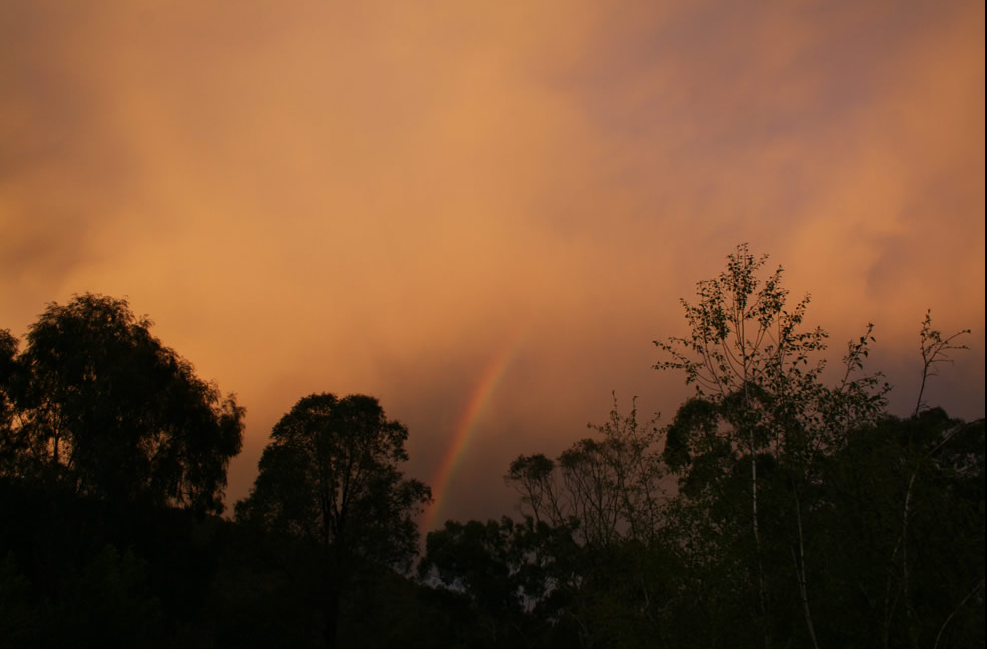Sunday in Australia
Sunday in Australia: A Spectacular Display of Atmospheric Optics
On Sunday, October 11th, residents of Bright, Victoria, Australia were treated to a breathtaking display of atmospheric optics. Rob Kaufman, an avid observer of atmospheric phenomena, captured stunning images of a primary and color-reversed secondary rainbow during the late afternoon. The secondary bow, which appeared broader than the primary, was a result of the rays forming it making a more glancing angle with raindrops, causing the colors to disperse more widely.
The primary rainbow, typically characterized by its vibrant colors, competed for attention with the sunset-lit clouds, resulting in a beautiful reddened hue. Earlier in the day at 4:40 PM, Kaufman witnessed another mesmerizing phenomenon known as cloud iridescence. This optical phenomenon occurs when tiny water droplets or ice crystals in the clouds diffract sunlight, creating a stunning display of vibrant colors.
Exploring the Primary and Secondary Rainbows
The primary rainbow is a familiar sight to many, appearing as a semicircular arc of colors in the sky. It is formed when sunlight is refracted, or bent, as it enters a raindrop, then reflected off the inside surface of the drop, and finally refracted again as it exits the drop. The different colors of the rainbow are a result of the varying angles at which the light is bent and reflected within the raindrop.
The secondary rainbow, on the other hand, is less commonly observed but equally fascinating. It appears as a larger and fainter arc above the primary rainbow. The formation process of the secondary rainbow involves an additional reflection within the raindrop before exiting. This second reflection causes the light to undergo a more significant change in direction, resulting in a broader dispersion of colors.
Understanding Color Dispersion in Rainbows
The phenomenon of color dispersion plays a crucial role in the appearance of rainbows. When sunlight enters a raindrop, it is made up of a spectrum of colors, each with a different wavelength. As the light is refracted and reflected within the drop, the different wavelengths of light are separated or dispersed. This dispersion is responsible for the distinct bands of colors observed in a rainbow.
In the case of the secondary rainbow, the rays of light that form it make a more glancing angle with the raindrops compared to those forming the primary rainbow. This increased angle of incidence results in a wider dispersion of colors, making the secondary rainbow appear broader and fainter than its primary counterpart.
The Beauty of Cloud Iridescence
Cloud iridescence, as witnessed by Rob Kaufman earlier in the day, is another captivating atmospheric optical phenomenon. It occurs when sunlight interacts with tiny water droplets or ice crystals in the clouds, causing diffraction, interference, and scattering of light. The result is a stunning display of iridescent colors, reminiscent of the vibrant hues seen on soap bubbles.
The colors seen in cloud iridescence are often pastel shades, including hues of pink, blue, purple, and green. These delicate colors are a result of the diffraction and interference of light waves as they interact with the small particles within the clouds. The precise size and shape of these particles contribute to the specific patterns and colors observed in cloud iridescence.
Appreciating Nature's Optical Wonders
Experiencing atmospheric optics phenomena, such as rainbows and cloud iridescence, is a reminder of the beauty and complexity of our natural world. These optical displays serve as a testament to the intricate interplay between sunlight, water droplets, and atmospheric conditions. By taking the time to observe and appreciate these wonders, we gain a deeper understanding of the physics behind them and develop a greater sense of awe for the natural phenomena that surround us.
In conclusion, the Sunday in Australia was a remarkable day for atmospheric optics enthusiasts. The images captured by Rob Kaufman showcased the brilliance of primary and secondary rainbows, as well as the enchanting beauty of cloud iridescence. These phenomena remind us of the marvels that can occur when light interacts with water droplets and ice crystals in our atmosphere. By embracing these moments and delving into the science behind them, we can unlock a world of captivating optical wonders right above our heads.

Australian Optics - Sunday 11th October at Bright, Victoria, Australia. Rob Kaufman (atmospheric optics site) imaged (top) this late afternoon primary and colour reversed secondary rainbow. The secondary bow is always broader because rays forming it make a more glancing angle with raindrops and colours are then dispersed more widely. Below: A reddened primary competes with sunset lit clouds. Bottom image: Earlier at 4:40 he saw spectacular cloud iridescence.�Rob Kaufman, shown with permission..


Note: this article has been automatically converted from the old site and may not appear as intended. You can find the original article here.
Reference Atmospheric Optics
If you use any of the definitions, information, or data presented on Atmospheric Optics, please copy the link or reference below to properly credit us as the reference source. Thank you!
-
<a href="https://atoptics.co.uk/blog/sunday-in-australia/">Sunday in Australia</a>
-
"Sunday in Australia". Atmospheric Optics. Accessed on November 26, 2024. https://atoptics.co.uk/blog/sunday-in-australia/.
-
"Sunday in Australia". Atmospheric Optics, https://atoptics.co.uk/blog/sunday-in-australia/. Accessed 26 November, 2024
-
Sunday in Australia. Atmospheric Optics. Retrieved from https://atoptics.co.uk/blog/sunday-in-australia/.